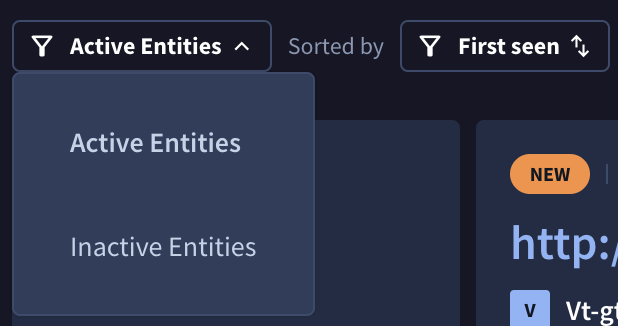Entities
An Entity is an external asset belonging to an organization such as a domain name, email address, or URL. Every Entity that is found serves as a pivot point for additional data gathering.
For a list of available Entities in ASM, see Entity types.
Recent Entities List
The Entities page of ASM shows you a list of the most recent Entities that were inspected in the selected Collections. Each Entity listing contains:
-
Its status, type, and country
-
The name of the Entity
-
The Collection containing the Entity
-
The number and severity of associated Issues
-
Any tags associated with it
-
The first and last times it was seen
-
Associated technologies
If there isn't a vendor-specific logo associated with a technology, a generic icon is displayed.

Active and Inactive Filter
On the Entities page, you will see filter options based on the following definitions:

- Active Entities: Entities that have been seen in the most recent scan.
- Inactive Entities: Entities that were seen in a previous scan and were not seen in the most recent scan.
Entity Overview
From the Entities page, open an Entity to explore it in depth. If applicable to the Entity type, you can set the Entity Out Of Scope. You can review or add notes. Associated Issues are listed. Additional context surrounding the Entity may include:
- Details: Information about the Entity.
- Scan History: Changes that have occurred to the Entity over time.
- Raw (JSON): The raw JSON structure of the query itself.
- Discovery Context: A visual representation of the discovery path and context identified during the discovery and attribution process of the Entity.
- Checks: Checks that have been run on the Entity. Links to the Library definitions are provided.
- Technologies: Technologies associated with the Entity. Links to the Library definitions are provided.
- Inferred CVE: Inferred vulnerabilities (CVEs) that were found in the Entity.
- Potential Typosquats: Domains that have been identified as potential typosquats but may be legitimate websites.

Entity Types
The following table provides a list of Entities available in ASM, categorized by type:
| Entity Type | Entity Name | Entity Description |
|---|---|---|
| Applications | API Endpoint (ApiEndpoint) | A HTTP based API endpoint |
Application Endpoint (AppEndpoint) | A HTTP / HTTPS application endpoint | |
Certificate (SslCertificate) | A Digital Certificate | |
| GcpApiGateway | Google Cloud Platform API Gateway | |
| GcpAppEngineApplication | Google Cloud App Engine Application | |
| GcpCloudFunction | Google Cloud Platform Cloud Function that is public facing and triggered via HTTP | |
Network Service (NetworkService) | A TCP or UDP Network Service | |
URL (Uri) | A HTTP / HTTPS application endpoint | |
| Code | Github Account (GithubAccount) | A FQDN of a Github Account |
Github Repository (GithubRepository) | A FQDN of a Github Repository | |
| Domains & Networking | Autonomous System (AutonomousSystem) | Unique Autonomous System ID, advertised globally to publish network routes |
DNS Record (DnsRecord) | DNS Subdomain, any type of DNS record that is not an authoritative domain | |
| Domain | An Authoritative Domain | |
| Nameserver | An FQDN or an IP Address that points to a Nameserver | |
Network (NetBlock) | A Block of IPs, in CIDR format | |
| Hosts & Compute | AWS EC2 (AwsEC2Instance) | An AWS EC2 Compute Instance |
Azure Virtual Machine (AzureVirtualMachine) | An Azure Virtual Machine | |
| GcpComputeEngineInstance | Google Cloud Compute Engine Instance | |
IP Address (IpAddress) | An IPv4 or IPv6 Address | |
| Storage | AWS RDS (AwsRdsDbInstance) | An AWS RDS Database Instance |
AWS S3 (AwsS3Bucket) | An S3 Bucket | |
| AzureStorageAccount | An Azure Storage Account | |
| GcpCloudSQLInstance | Google Cloud Platform Cloud SQL Instance | |
| GcpStorageBucket | Google Cloud Platform Storage Bucket | |
| System | Unique Keyword ( | A globally unique keyword that can be reliably searched |
| Users & Access | API Token (UniqueToken) | An api key or analytics id |
Email Address (EmailAddress) | An Email Address |
Updated 2 days ago